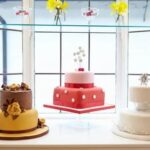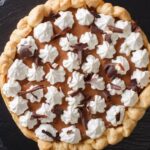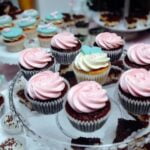When it comes to cakes, one of the most important aspects that can elevate its visual appeal and overall presentation are decorations. These elements are like the finishing touches that add a touch of creativity and charm to an otherwise ordinary cake. From simple sprinkles to intricate sugar flowers, decorations play a significant role in enhancing the aesthetic appeal of a cake.
But what do you call decorations you stick on a cake? These are commonly known as “cake toppers” or simply “decorations”.
Cake decorations come in various forms, each adding its unique flair to the dessert. Fondant, icing, sugar flowers, edible images – these are just some of the types of decorations that can transform a plain cake into a masterpiece. The art of decorating cakes has evolved over time, reflecting different trends and preferences.
Whether you’re looking to add a personal touch to your cake or want to explore professional-grade decorations, understanding common terminology like toppers, sprinkles, drages, and confetti is essential. In this article, we will delve into the world of cake decorations – from their historical background to DIY tips for creating your own at home. Let’s discover how these small elements can make a big difference in making your cake not only delicious but visually stunning as well.
Types of Cake Decorations
Cake decorations play a vital role in enhancing the visual appeal of a cake and making it stand out on special occasions. There are various types of decorations that can be used to adorn a cake, each adding its own unique touch to the sweet treat. Here are some key types of cake decorations commonly used in the world of baking:
- Fondant: Fondant is a popular choice for covering cakes and creating intricate designs. It is a pliable icing that can be rolled out and shaped into different forms, making it ideal for sculpting detailed decorations.
- Icing: Icing is another versatile option for decorating cakes, whether it be buttercream icing for smooth finishes or royal icing for intricate piped designs. Icing can add color, texture, and flavor to a cake.
- Sugar Flowers: Sugar flowers are delicate edible decorations crafted from sugar paste or gum paste. These intricate flowers can add elegance and beauty to any cake design, mimicking real flowers with stunning realism.
- Edible Images: Edible images are printed designs on thin sheets of icing that can be placed directly onto a cake’s surface. They offer endless possibilities for customization, allowing for personalized messages, photos, or graphics on a cake.
Understanding the different types of cake decorations available can help bakers choose the best option to achieve their desired aesthetic and theme for a cake. Whether using fondant for sculpted creations, icing for colorful embellishments, sugar flowers for elegance, or edible images for personalization, each type of decoration brings its own charm to the delightful world of cake decorating.
Expanding your skills in working with various types of decorations can open up endless creative possibilities when it comes to designing stunning cakes for any occasion. Experimenting with different techniques and materials allows bakers to unleash their creativity and bring their cake decorating visions to life.
So next time you’re wondering what do you call decorations you stick on a cake – remember the vast array of options available and let your imagination run wild as you adorn your next confectionery masterpiece.
Historical Background
Cake decorations have been an integral part of culinary arts for centuries, evolving from simple garnishes to elaborate designs that are almost too beautiful to eat. The history of cake decorations can be traced back to ancient civilizations like the Egyptians, who used nuts and dried fruits as embellishments on their sweet treats. As time passed, different cultures began incorporating unique techniques and ingredients to adorn their cakes, leading to the wide variety of decorations we see today.
To understand the evolution of cake decorations, it is important to recognize the influence of European confectioners during the Renaissance period. These skilled artisans introduced intricate sugar sculptures, known as “subtleties,” which were often displayed as centerpieces at grand feasts. The artistry and creativity in these edible creations paved the way for more sophisticated cake decorations in later centuries.
In modern times, advancements in technology have revolutionized the way cake decorations are made and applied. From delicate sugar flowers handcrafted by skilled pastry chefs to edible images printed with food-safe ink, there is no limit to the creativity that can be achieved. Whether it’s using traditional fondant or experimenting with new techniques like mirror glaze or wafer paper flowers, today’s bakers have a wealth of options when it comes to decorating cakes for any occasion.
DIY Cake Decorations
Cake decorations are an essential part of making a cake visually appealing and adding a personal touch to any special occasion. While store-bought decorations are readily available, creating your own DIY cake decorations can elevate the overall look of your cake and showcase your creativity. Whether you’re a baking enthusiast or just looking to try something new, experimenting with DIY decorations can be a fun and rewarding experience.
One popular option for DIY cake decorations is fondant, a versatile sugar paste that can be rolled out and shaped into various designs. From intricate flowers to geometric shapes, fondant offers endless possibilities for customizing your cake.
Another common technique for DIY decorations is piping icing, which allows you to create detailed patterns, borders, and even written messages on your cake. With some practice and the right tools, you can master the art of piping and add a professional touch to your homemade creations.
For those looking to add a more unique touch to their cakes, edible images are another great DIY decoration option. Edible images allow you to transfer photographs or custom designs onto a thin layer of icing using food coloring.
This technique is perfect for commemorating special events like birthdays or anniversaries, as it allows you to personalize your cake with meaningful images or messages. Regardless of which DIY decoration method you choose to explore, the key is to have fun and let your imagination soar as you create beautiful designs that will impress both friends and family alike.
Common Terminology
Cake decorations come in a variety of forms and play a crucial role in enhancing the visual appeal of a cake. From birthday parties to weddings, cake decorations are an essential element that can elevate the overall presentation of a dessert. One common question that often arises is, “What do you call decorations you stick on a cake?” These decorations are known by various terms depending on their type and purpose.
One popular type of decoration for cakes is toppers. Toppers are decorative elements that are placed on top of a cake to enhance its appearance and convey a specific theme or message. They can range from simple figurines representing characters or objects to elaborate designs like monograms or floral arrangements. Toppers come in various materials such as plastic, wood, or edible fondant, offering endless possibilities for customization.
Another common term used to describe cake decorations is sprinkles. Sprinkles are small particles or shapes made from sugar, chocolate, or candy that are scattered on top of a cake to add color and texture.
They come in different sizes, colors, and flavors, allowing bakers to create unique designs and patterns on their cakes. Whether it’s rainbow sprinkles for a fun birthday cake or metallic sprinkles for an elegant wedding cake, these tiny decorations can make a big impact on the overall look of the dessert.
| Types of Cake Decorations | Types of Materials |
|---|---|
| Toppers | Plastic, Wood, Fondant |
| Sprinkles | Sugar, Chocolate, Candy |
Professional Cake Decorators
Techniques Used by Professional Cake Decorators
Professional cake decorators often employ a variety of techniques to achieve their desired aesthetics. From piping delicate buttercream flowers to sculpting fondant figurines by hand, these artists showcase their talent through intricate designs. Some decorators specialize in using airbrushing or edible painting to add custom details and vibrant colors to their creations. The use of stencils, edible glitter, and sugar lace are also common techniques used by professionals to add texture and dimension to their cakes.
Innovation in Cake Decoration
In addition to traditional techniques, professional cake decorators are constantly pushing the boundaries of creativity in the world of cake decoration. They experiment with new materials like isomalt for creating delicate sugar decorations or incorporating 3D printing technology to design unique cake toppers.
These innovative approaches allow for endless possibilities when it comes to decorating cakes, bringing fresh ideas and trends into the industry. Whether it’s creating gravity-defying structures or incorporating interactive elements into a cake design, professional decorators continue to impress with their imaginative concepts.
Celebrity Cake Decorators
Some professional cake decorators have gained fame in the industry due to their exceptional skills and unique aesthetic. These celebrity decorators often work on high-profile events like celebrity weddings or major corporate celebrations, showcasing their talent on a grand scale.
Their work is not only visually breathtaking but also serves as inspiration for aspiring bakers and decorators worldwide. Through social media platforms and television shows focusing on baking competitions, these celebrity cake decorators have become household names, further highlighting the importance of skilled professionals in the art of cake decoration.
Edible vs Non-Edible Decorations
When it comes to decorating a cake, one of the key decisions to make is whether to use edible or non-edible decorations. Edible decorations, such as chocolate shavings, fondant accents, and sugar flowers, not only add visual appeal but also contribute to the overall taste of the cake.
These decorations are meant to be consumed along with the cake itself, enhancing the flavor and texture of each bite. On the other hand, non-edible decorations like plastic figurines, paper cutouts, and even candles are used for decorative purposes only and should be removed before serving or consuming the cake.
Edible Decorations
Edible decorations offer a wide range of options for adding flair to a cake. From intricately designed fondant pieces that resemble works of art to simple yet elegant chocolate curls or sprinkles, these decorations can elevate a plain cake into a stunning masterpiece. Edible images printed on thin sheets of sugar are another popular choice for personalized cakes, allowing for custom designs that reflect any theme or occasion.
Non-Edible Decorations
Non-edible decorations are typically used when creating themed cakes or special occasion cakes where certain elements need to be showcased without being consumed. Plastic figurines depicting characters from movies or cartoons, miniature objects like cars or animals, and even sparkler candles fall under this category. While these decorations add an extra element of fun or elegance to a cake, they should be removed before slicing and serving to avoid any accidents or unwanted consumption.
Whether opting for edible decorations that enhance both the look and taste of a cake or non-edible decorations that serve a purely decorative purpose, choosing the right type of embellishment is essential in achieving the desired aesthetic for any confectionary creation. The distinction between edible and non-edible decorations plays a crucial role in not only shaping the visual appeal but also determining how the final product is enjoyed by those partaking in the delicious treat.
Trends in Cake Decoration
Cake decoration trends are constantly evolving, reflecting changes in taste, style, and design preferences. In recent years, several innovative cake decoration trends have emerged that have taken the baking world by storm.
One of the most popular trends is drip cakes, which feature colorful drips of icing cascading down the sides of a cake. These drip cakes add a modern and artistic touch to traditional cake designs, creating a visually stunning effect that can be customized to match any event or theme.
Another trendy cake decoration style is geode cakes, inspired by the beauty of natural crystals and gemstones. Geode cakes typically involve using rock candy or edible sugar crystals to create a stunning geode-like pattern within the layers of a cake. The intricate and intricate designs of geode cakes make them a striking centerpiece for special occasions such as weddings and birthdays. This trend has become particularly popular due to its unique and eye-catching appearance.
On the opposite end of the spectrum are naked cakes, which have gained popularity for their simplistic and rustic charm. Naked cakes are characterized by their minimal frosting on the outside, with the layers of cake exposed between each tier. These cakes are often adorned with fresh flowers, fruits, or other natural elements to enhance their organic look. Naked cakes have become a favorite choice for couples seeking a more relaxed and understated dessert option for their wedding celebrations.
| Cake Decoration Trend | Description |
|---|---|
| Drip Cakes | Colorful drips of icing cascading down the sides of the cake for a modern and artistic touch. |
| Geode Cakes | Inspired by natural crystals and gemstones with rock candy or sugar crystals creating intricate geode patterns. |
| Naked Cakes | Minimal frosting on the outside with visible layers of cake between tiers decorated with fresh flowers or fruits. |
Conclusion
In conclusion, the art of cake decoration plays a crucial role in elevating the visual appeal of a cake and creating a memorable experience for both the eyes and the taste buds. Whether it is a simple birthday cake adorned with colorful sprinkles or an elaborate wedding cake featuring intricate sugar flowers, decorations are what truly make a cake stand out and leave a lasting impression on those enjoying it.
The effort put into selecting the right decorations and skillfully arranging them on a cake can turn even the most basic dessert into a work of edible art.
Furthermore, understanding the historical background of cake decorations provides insight into how this practice has evolved over time, from simple icing techniques to complex fondant designs. With advancements in technology and techniques, cake decorators now have access to a wide array of tools and materials to unleash their creativity and bring their visions to life.
From DIY enthusiasts experimenting with homemade decorations to professional bakers creating show-stopping masterpieces, the world of cake decoration continues to flourish as an essential aspect of culinary arts.
In essence, whether it’s discussing terms like toppers, sprinkles, drages, and confetti or exploring current trends like drip cakes or geode cakes, one thing remains certain: cake decorations hold a special place in celebrations and special occasions. They not only add beauty to a cake but also allow for personalization and creative expression.
So next time you indulge in a delicious slice of cake adorned with those little embellishments that make it extra special – remember that these decorations play a significant role in creating a delightful sensory experience.
Frequently Asked Questions
What Do You Stick Things on Cakes With?
Sticking things on cakes is commonly done using toothpicks or skewers to secure decorations in place. In some cases, edible glue made from ingredients like powdered sugar and water can also be used.
What Is the Names of Cake Decorations?
Cake decorations come in a variety of forms and names such as fondant, edible pearls, sprinkles, edible flowers, chocolate shavings, and marzipan figures. These decorations can be used to enhance the visual appeal of a cake.
What Is the Thing Used to Decorate Cakes Called?
The tool specifically used for decorating cakes is known as a piping bag or pastry bag. It is typically filled with frosting or icing and fitted with various tips to create different designs such as swirls, dots, and intricate patterns on cakes. Professional bakers often use this tool for precise decorative work.

Welcome to my blog about home and family. This blog is a place where I will share my thoughts, ideas, and experiences related to these important topics. I am a stay-at-home mom with two young children. I hope you enjoy reading it! and may find some helpful tips and ideas that will make your home and family life even better!





